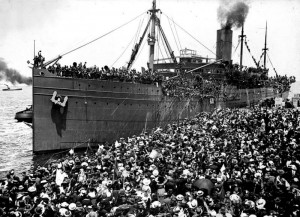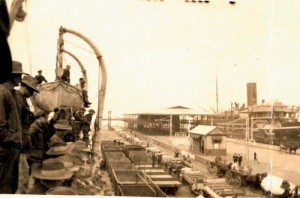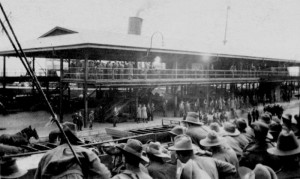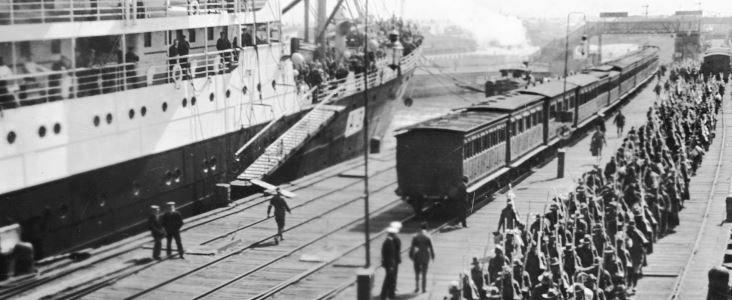Port Melbourne
First convoy

Hororata 1916, courtesy State Library of Victoria.
When the Great War broke out in August 1914, the Australian Government pledged its support for Britain. A rush of volunteers enlisted for the first Australian Imperial Force (AIF) and they were moved into makeshift camps for training.
Due to the size of the first convoy in World War I, all three piers at Port Melbourne were used; Town Pier, New Railway Pier (Princes Pier) and Railway Pier (Station Pier).
- Between 17 and 21 October 1914, sixteen vessels that would form the first convoy left Port Phillip Bay carrying troops, horses and supplies.
- With German raiders patrolling the Pacific, there was an air of secrecy surrounding the departures of the first convoy. Anxious friends and relatives got wind of the news and descended on the port in droves to catch a glimpse of their loved ones before they set off.
- Civilians were not permitted onto the piers, but the crowd swell grew and as the last vessel of the convoy, the Orvieto, made ready to leave, the crowd overwhelmed the guards and swarmed onto the pier. Strains of the national anthem rose up and streamers sailed through the sky as well-wishers watched their loved ones depart for the uncertainty of war.
Princes Pier
Princes Pier in particular, or as it was known then, the New Railway Pier, played a vital role as the arrival and departure point for Australian troops during this time.
- On 29 September 1914, the New Railway Pier (Princes Pier) was christened when the first Australian convoy carrying troops to fight in World War I left for the battlefields from the newly completed first section of the pier.
- The troop ships, the Rangatira and the Star of England, both down from Queensland, were the first vessels ever to berth at the half completed pier.
- At the end of the war, most of the troops who returned to Melbourne disembarked at Princes Pier.
End of the war and returning troops

Boarding Shropshire 1916, Port Melbourne. Courtesy State Library of Victoria.
With the growing list of Australian casualties, hospital ships carrying wounded servicemen began arriving back at Port Melbourne, where the mood was often sombre.
- The war ended in November 1918 with the signing of an armistice, but there was a delay in arranging ships to bring the Anzacs home from England. It was another six months before WWI service men and women were welcomed home at Port Melbourne.
- The troops’ much anticipated return was prolonged even further. With an influenza pandemic sweeping the globe, the ships were quarantined at Point Nepean for fear returning servicemen would cause an influenza outbreak in Australia. Victorian daily papers published lists of personnel travelling on each ship.
- When troop ships were expected, The Royal Automobile Club of Victoria appealed to motorists to drive to the pier to help transport wounded soldiers to the military depot in Sturt Street, South Melbourne where they were discharged.
Sources:
Barnard, J. and Jennings, S. 2004, Welcome and Farewell: The Story of Station Pier, Arcadia, Melbourne, VIC.
Barnard, J. 2011, Princes Pier Port Melbourne: Draft Thematic History, Melbourne, VIC.
STORIES OF SOLDIERS
Farewell my brother

Port Melbourne 1919. Courtesy State Library of Victoria.
A long line of motors waiting to take us to Barracks Port Melbourne Date 1919. Pictures Collection, State Library of Victoria.
Brian Lewis farewelled three of his brothers from the Port Melbourne piers when they departed for the First World War.
A fuss at camp and somebody would get a message to Melbourne and a crowd would turn up for the “secret” departure. It was a big ship with rows of faces along the rails and it was hard to pick out Athol, but Mrs Calder got some photographs. As the ship pulled out, the rolls were unwound and the streamers got longer and longer until they were so long that the wind broke them. The last one broke and the faces became too small to recognise …¹
By May 1915, news of the heavy casualties suffered by Australians at Gallipoli made its way home and the farewell of Australian troops became marked by a growing sense of apprehension.
On 21 November 1917, Private W.L. Clark boarded the Nestor at Port Melbourne Pier with the 22nd Battalion. As soon as the men were assigned their messes, Private Clark wrote, they…
joined in a wild rush for the deck, our object being the securing of a good position on the side of the boat, in order to be able to see and converse with the relations and friends who were crowding on the pier to see us leave. I had no difficulty in seeing my friends amongst whom were included my brother, and seeing him there, set me thinking as to whether I will ever see him again.²
Private Clark’s apprehension was realised – he never did see his brother again. Private Clark was killed in France on 22 May 1918.
Sources:
Barnard, J. and Jennings, S. 2004, Welcome and Farewell: The Story of Station Pier, Arcadia, Melbourne, VIC.
¹Brian Lewis quoted in Barnard, J. and Jennings, S. 2004, Welcome and Farewell: The Story of Station Pier, Arcadia, Melbourne, VIC, p 60.
²Diary of Private W.L. Clark quoted in Barnard, J. and Jennings, S. 2004, Welcome and Farewell: The Story of Station Pier, Arcadia, Melbourne, VIC, pp. 64-5.
Return of the Wounded

Port Melbourne Pier in 1919.
With the growing list of Australian casualties, hospital ships carrying wounded servicemen began arriving back at Port Melbourne, where the mood was often sombre.
In 1917, Brian Lewis went to meet his brother Ralph, who had been wounded in France.
The ship pulled in to the grey wharf where a quiet clump of relatives waited in silence. The gangway was put down and men with empty sleeves, men on crutches and men hobbling with sticks came down it; at least their kit-bags were carried down with them. Then down came the stretchers and parents were able to talk for a minute or two before they were put into ambulances.¹
Sources:
Barnard, J. and Jennings, S. 2004, Welcome and Farewell: The Story of Station Pier, Arcadia, Melbourne, VIC.
¹Brian Lewis quoted in Barnard, J. and Jennings, S. 2004, Welcome and Farewell: The Story of Station Pier, Arcadia, Melbourne, VIC, p. 66.
Port Melbourne today
Princes Pier
The Victorian Government recognised Princes Pier as an important part of Victoria’s maritime history and committed $34 million to its restoration, securing the future of this historic landmark.
Restored and modified to allow safe public access, Princes Pier reopened as a public space in December 2011.
Princes Pier is included in the Victorian Heritage Register as a site of historical and architectural significance to the State of Victoria. It is one of Melbourne’s most important waterfront locations, playing a key role in Australia’s wartime and multicultural history.
The redevelopment of Princes Pier is part of the broader plan to revitalise the entire foreshore precinct in Port Melbourne back to life and is the final stage of the Beacon Cove development.
Station Pier
Station Pier is still a Port Melbourne landmark, operating as the major Victorian passenger terminal for cruise ships and the Tasmanian ferry services.






